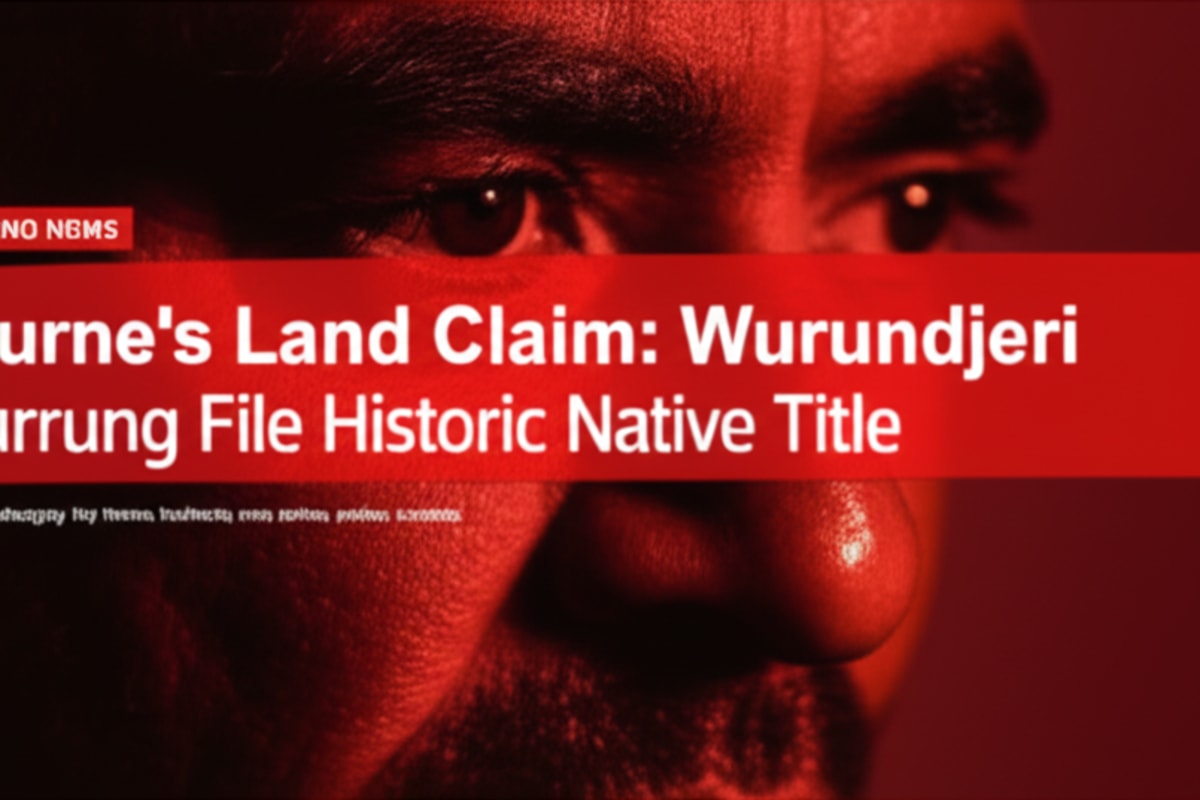Melbourne's Land Claim: Wurundjeri Woi-wurrung File Historic Native Title

Melbourne, a city celebrated globally for its vibrant culture, bustling laneways, and impressive modern skyline, stands on a history far deeper and older than its colonial foundations
Background
Now, that ancient heritage is asserting itself in a profound and incredibly significant way
The Wurundjeri Woi-wurrung people, the traditional custodians of this land, have officially lodged a native title claim that encompasses not just the sprawling metropolis itself, but thousands of square kilometres of surrounding regions
A Claim Spanning Millennia: Defining Ancestral Lands This isn't just a bureaucratic filing; it's a powerful statement of enduring connection and a call for a new era of stewardship
The claim, submitted by the Wurundjeri Woi-wurrung, stretches across an immense area of what is now known as Victoria.
To truly grasp its scale, imagine a line from the mouth of the Werribee River, tracing its path northwards all the way to its headwaters nestled in the Great Dividing Range
From there, it sweeps east towards the majestic Mount Baw Baw, then south through the tranquil Bunyip area, before heading west to Mordialloc Creek.
This expansive territory underscores the sheer scale of the Wurundjeri Woi-wurrung’s ancestral domain, a connection that has survived millennia and continues to define their identity and responsibilities
At the heart of this landmark action lies a deep-seated desire, eloquently articulated by a Wurundjeri Woi-wurrung elder. It's a vision that moves beyond conventional land ownership.
“The claim would allow First Nations people to work with government to ‘look after that country’,” the elder stated, highlighting the profound responsibility and intrinsic connection to the land that is central to their culture. It's a sentiment that echoes through generations, speaking of a responsibility to care for the land, not merely to own it in a Western sense.
This isn't about exclusive ownership or removing current residents; it's fundamentally about co-management, shared responsibility, and ensuring the health and cultural integrity of the country for everyone, for generations to come
This approach acknowledges that the best way to preserve and sustain the land is through the wisdom and guidance of its original stewards
The Wurundjeri Woi-wurrung people have filed a native title claim covering thousands of square kilometres across Melbourne and surrounding regions, with the primary intent to enable First Nations people to work with government on co-management and cultural stewardship of the land, not to remove existing property rights
Unpacking Native Title: Beyond Western Ownership For those unfamiliar with the intricacies of Australian native title, it’s worth a moment to unpack what this really means
Native title recognises that Aboriginal and Torres Strait Islander peoples have rights and interests in land and waters, which derive from their traditional laws and customs, and that have been continuously held since before British colonisation
It's not the same as freehold title, which grants absolute ownership; instead, it often involves shared rights, such as access for hunting, fishing, or cultural ceremonies, or consultation rights over land use
Crucially, native title typically does not extinguish existing valid freehold or leasehold interests. So, if you own a home or run a business in Melbourne, your property isn't suddenly up for grabs.
What it does introduce is a framework for recognition, negotiation, and partnership, ensuring that Indigenous voices are heard and respected in decisions impacting their traditional lands
This claim builds on decades of legal precedent in Australia, a journey marked by both challenges and triumphs
The pivotal moment arrived with the 1992 Mabo decision by the High Court of Australia, which famously overturned the doctrine of terra nullius – the colonial legal fiction that Australia was 'land belonging to no one' prior to European settlement
This groundbreaking ruling paved the way for the Native Title Act 1993, establishing a legal framework for Indigenous Australians to claim their traditional rights to land and waters
Since then, numerous subsequent legislation and court rulings have slowly but surely broadened the scope of Indigenous land rights.
Each step has been hard-won, a testament to the perseverance and resilience of First Nations peoples across the continent who have tirelessly fought for justice and recognition of their unbroken connection to country
Profound Implications for Victoria and Reconciliation So, what does this mean for Melbourne, for Victoria, and for Australia's ongoing journey of reconciliation
The implications are significant and far-reaching, marking a critical juncture in the state’s history
For the Victorian government, it means a new, formal partner in land use planning, environmental management, and cultural heritage protection across a vast and economically vital region
This partnership isn't merely symbolic; it mandates genuine engagement and collaboration, potentially leading to more sustainable and culturally sensitive development outcomes
Shaping Future Development and Environmental Stewardship For developers, it necessitates genuine consultation and potentially new frameworks for agreements, ensuring that future projects respect and incorporate Indigenous perspectives and heritage
Imagine development not just as concrete and steel, but as an opportunity to reflect and celebrate thousands of years of continuous culture
This could involve co-designing projects that integrate traditional ecological knowledge, protecting significant cultural sites, and creating economic opportunities for Indigenous communities
For environmental conservation, the claim holds immense potential
The Wurundjeri Woi-wurrung possess invaluable traditional ecological knowledge, honed over millennia, that can guide efforts to combat climate change, protect biodiversity, and manage natural resources
Their insights into fire management, water systems, and flora/fauna can provide crucial pathways to a healthier environment for all
For the average Melburnian, it presents an incredible opportunity for deeper understanding and connection.
It's a chance to learn about the Birrarung (Yarra River) from those who have known it intimately for millennia, to understand the stories embedded in every hill and valley
This claim could lead to enhanced cultural tourism experiences, environmental initiatives guided by traditional ecological knowledge, and a richer, more inclusive public discourse around the city's identity and future
It's about acknowledging the true history of the land beneath our feet and embracing a shared future built on mutual respect and understanding
This action represents a significant step towards reconciliation and will profoundly impact future urban planning, environmental management, and cultural heritage protection in Victoria
A Shared Global Narrative: Southeast Asian Parallels Globally, and particularly for our neighbours in Southeast Asia, this claim resonates deeply
Many nations in our region grapple with similar issues of indigenous land rights, the balance between economic development and cultural preservation, and the complex legacy of colonial histories.
From the ancestral domains of the Orang Asli in Malaysia, facing encroachments from logging and palm oil plantations, to the various Indigenous peoples of Indonesia and the Philippines, striving to protect their customary lands from mining and large-scale infrastructure projects, the struggle for recognition and self-determination is a shared and ongoing narrative
Melbourne's native title claim offers a compelling case study: how a developed nation is attempting to reckon with its past and build a more equitable future through legal and collaborative means
It highlights the universal importance of traditional ecological knowledge for sustainable practices, a wisdom that communities across Southeast Asia are also fighting to protect and uphold amidst rapid modernisation and climate change challenges
The outcomes in Melbourne could inspire similar legal or policy advancements in other parts of the world, demonstrating effective pathways for indigenous communities to assert their rights while fostering collaborative governance models
This native title claim in Melbourne is part of a broader global movement for indigenous rights and land recognition, highlighting the ongoing efforts by First Nations peoples worldwide to assert their sovereignty and protect their cultural heritage
Looking Ahead: Towards a Collaborative Future While the legal process of native title claims can be complex and lengthy, the filing of this claim is a monumental step
It forces a conversation, demanding that the city and state acknowledge the deep spiritual and cultural connection the Wurundjeri Woi-wurrung have to this land
It represents Australia's continuing journey towards reconciliation and the implementation of native title legislation, which aims to redress historical injustices and foster collaborative governance models
It's a hopeful sign that the vision of ‘looking after that country’ together – Indigenous and non-Indigenous peoples working side-by-side – might truly become a reality
This isn't just about land; it's about justice, recognition, and forging a shared future where the oldest continuous culture on Earth can thrive at the heart of one of its most modern cities
The claim underscores the critical role of traditional ecological knowledge in contemporary environmental conservation, a theme that resonates strongly with indigenous communities across Southeast Asia facing similar challenges
